

The shadow of the pandemic has loomed over the Australian economy for a second year. Australian Broker talks to 12 financial services industry leaders, who reflect on the challenges and achievements of 2021 and share their expectations for the year ahead.
People in the mortgage finance industry have barely been able to catch their breath this year, having been buffeted again by the fierce winds of COVID-19.
Widespread lockdowns and closed borders hurt small businesses, employment, education and construction. But federal and state government financial support mitigated the worst impacts, helping many workers and businesses stay afloat.
The property market boomed, with prices surging more than 20% nationally. Increased demand was fuelled by record-low interest rates. This was great news for brokers and lenders as clients sought loan options to fund their property goals.
Technology, mergers and acquisitions, open banking, industry regulation and diversification were important trends in 2021.
Australian Broker asked 12 industry leaders about the issues that shaped the year and what they believed 2022 would bring.
 Liberty group sales manager John Mohnacheff says the learnings from 2020 served the financial sector incredibly well this year. “While no one expected the year to bring such uncertainty, the industry has remained as resilient as ever,” he says.
Liberty group sales manager John Mohnacheff says the learnings from 2020 served the financial sector incredibly well this year. “While no one expected the year to bring such uncertainty, the industry has remained as resilient as ever,” he says.
One of the most notable changes brought about by COVID that the non-bank specialist lender has seen is the increased demand for flexible lending.
“For some lenders, this served as a catalyst for greater innovation, but specialist lending is something Liberty has offered for nearly 25 years,” Mohnacheff says. “And, with extensive experience in this space, our unique business model has enabled us to help business partners support customers with a range of complex needs.”
He says the pandemic has affected the Liberty community in many ways, requiring ongoing effort to continue to provide “the standard of service that our brokers and customers need”.
“With our head office located in Melbourne, early lockdowns taught us many important lessons about how best to navigate these challenging circumstances.
We know that a one-size-fits-all approach simply doesn’t work, but by exercising compassion, flexibility and innovation we continue to grow stronger as a business and as a brand.”
Mohnacheff says while the unemployment rate is higher than desired due to ongoing lockdowns, there are signs of a promising return as we head into the holidays.
“If we can avoid any major hiccups, there is significant opportunity for brokers to support those looking to ramp up their existing businesses or perhaps explore new avenues,” he says.
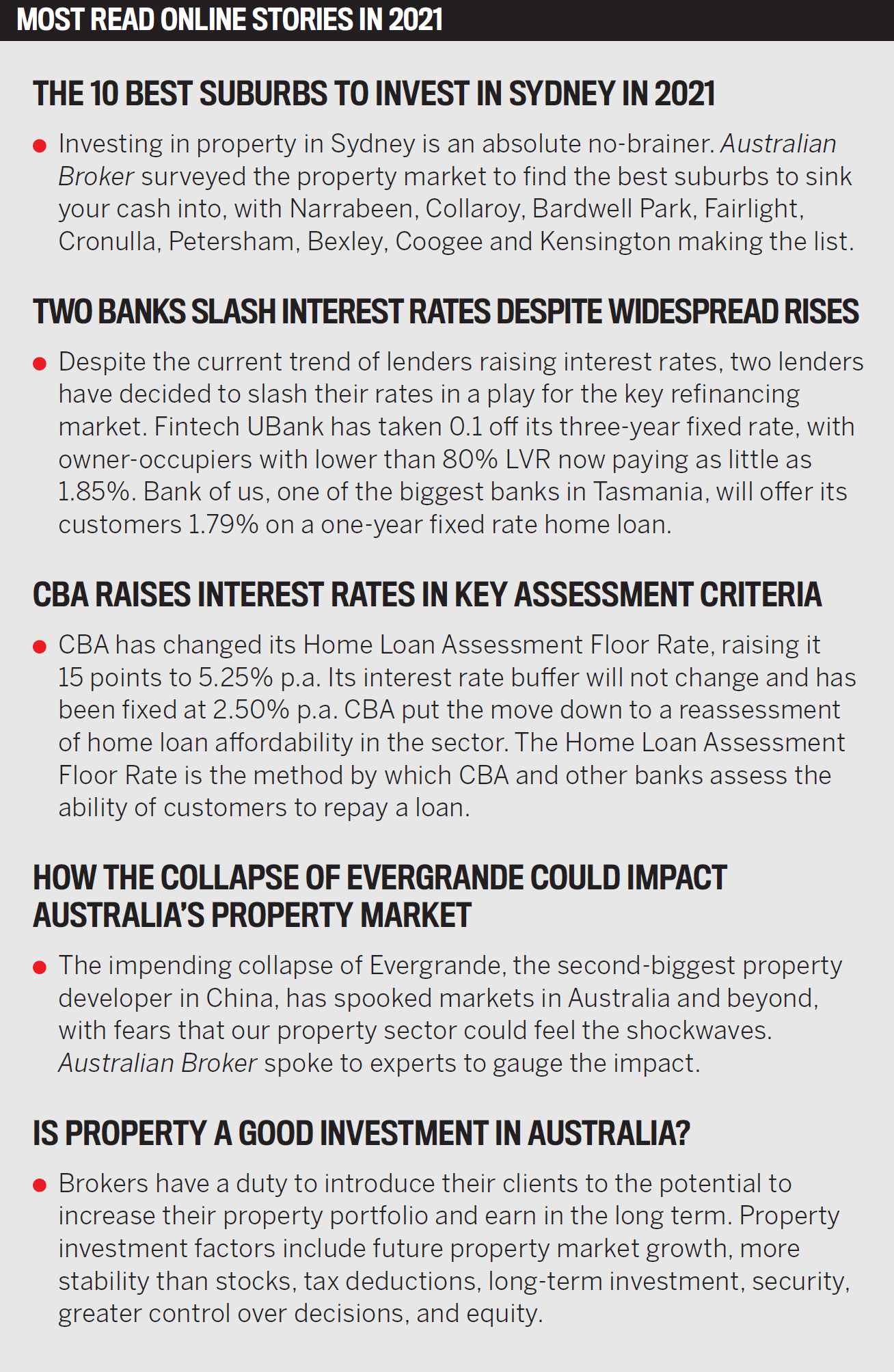 “Let’s not forget, with months of delayed purchases and investments in certain parts of the country, there is now likely to be an influx of customers eager to make up for lost time; whether it’s a new home, a new vehicle or even a major holiday, customers are ready to get back to their regular lives and are seeking funds to take the next steps.”
“Let’s not forget, with months of delayed purchases and investments in certain parts of the country, there is now likely to be an influx of customers eager to make up for lost time; whether it’s a new home, a new vehicle or even a major holiday, customers are ready to get back to their regular lives and are seeking funds to take the next steps.”
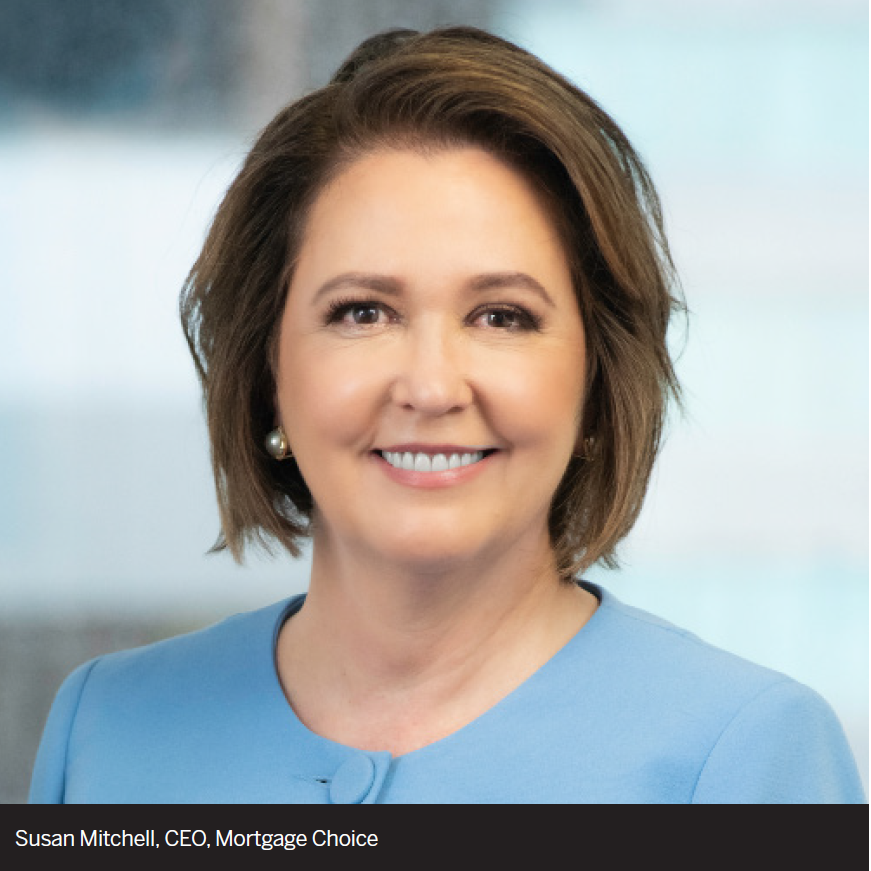 Susan Mitchell, CEO of Mortgage Choice, says the biggest change has been “increasing capacity within our respective businesses to manage the unforeseen record levels of mortgage activity”.
Susan Mitchell, CEO of Mortgage Choice, says the biggest change has been “increasing capacity within our respective businesses to manage the unforeseen record levels of mortgage activity”.
“The broking industry has invested heavily in technology, and it’s making broking platforms more efficient as well as improving customer experiences,” she says.
“It’s also never been easier for customers to communicate and work with their broker. For example, normalising digital signatures might seem like a small advancement during the pandemic, but the efficiency and time gained for brokers will be enormous.”
Mitchell says when the pandemic took hold in 2020, initial reactions were survivalist, but it soon became clear it was a time when customers would need brokers the most.
“The discussion soon turned to how do we – as an entire group – manage the overwhelming demand.
“What I have learnt most is that to meet the challenges in our forever-changing world, you have to be constantly communicating with your network. Listen to their concerns and ideas, and let them know when and why you’re taking action.”
One of the biggest challenges is lender turnaround times, says Mitchell.
“It’s absolutely critical that our support staff and brokers are across the details because it will impact customers’ decisions. An informed broker makes all the difference when it comes to customers feeling in control and confident in their decision-making.”
 La Trobe Financial senior vice president and chief lending officer Cory Bannister says 2021 will long be remembered as being a time of uncertainty, complexity and challenge.
La Trobe Financial senior vice president and chief lending officer Cory Bannister says 2021 will long be remembered as being a time of uncertainty, complexity and challenge.
“Where there is complexity and uncertainty there is often opportunity; and particularly for non-bank lenders, along with brokers, that has certainly been the case,” says Bannister.
“And that’s because non-banks are ideally suited to providing credit appropriately throughout this period, due to the custom nature of our credit assessments and our willingness to take the time to fully understand a customer’s unique position and then provide an appropriate tailored solution.”
Bannister says La Trobe Financial expected brokers would receive a major boost on the back of COVID, and that’s what happened, with brokers writing a record $78bn in the June quarter of 2021 alone – a 50% increase year-on-year.
He says these “tailwinds” for non-banks and brokers were blowing well before COVID, when the major banks simplified their strategies and vacated the “complex credit” space after the banking royal commission.
“However, there are a number of segments of the lending landscape that have been left with little support or credit availability at a critical time for the Australian economy. This includes SMEs in particular.
“This gap is now being filled in part by non-banks, which are all stepping in to fill the void for customers that would ordinarily be taken up by the major banks.”
Bannister says he doesn’t see this trend reversing any time soon, given that non-banks represent just 5% of Australia’s total lending market compared to about 20% pre-GFC.
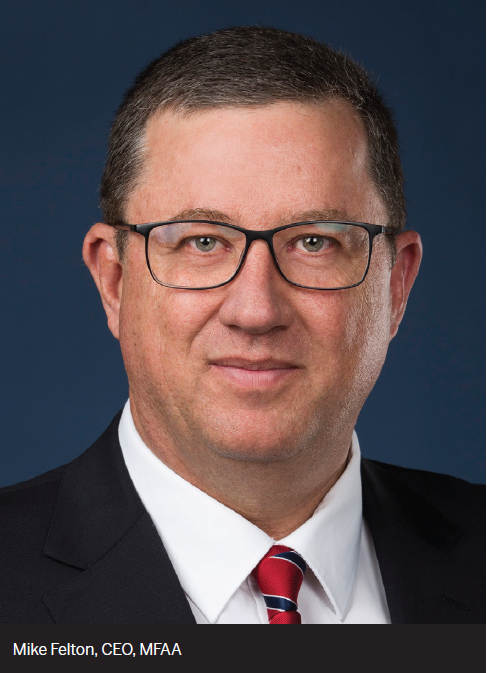 Mike Felton, CEO of the MFAA, says 2021 presented many challenges, and “our industry’s resilience and flexibility helped us rise above them again”.
Mike Felton, CEO of the MFAA, says 2021 presented many challenges, and “our industry’s resilience and flexibility helped us rise above them again”.
“Brokers’ adaptability to change and focus on customers proved once again to be the keys to success over the past year as our industry remained agile in the face of COVID-related process changes and the commencement of the single biggest legislative change our industry has faced in more than 10 years: the best interests duty,” Felton says.
“I’m very proud to say we have also remained true to the customer-first ethos that sets our industry apart. Brokers continued to put customers first at a time when Australians really needed them.”
Felton says this resilience and commitment produced incredible broker market share results – the latest figures show 66.9% or two thirds of all new residential home loans were written by brokers.
“The fact that we achieved our highest market share result to date during a year when customers were under so much pressure, approval times were very challenging and new regulations were implemented is inspirational.”
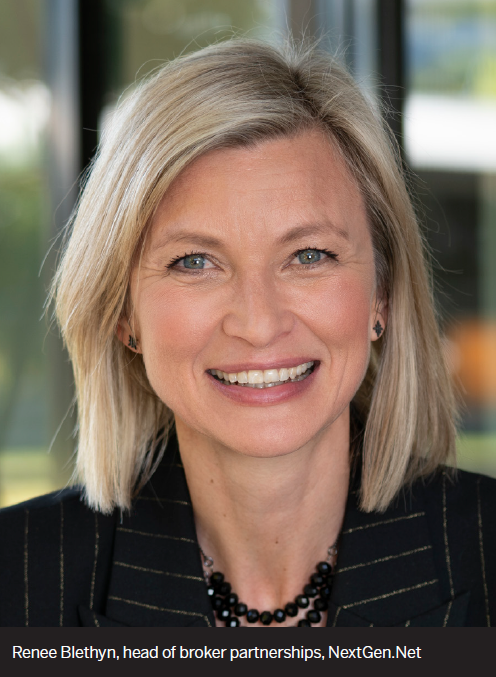 When COVID first hit, says NextGen.Net head of broker partnerships Renee Blethyn,the leading fintech moved its ApplyOnline user training online to educate the broker network on the latest digital tools to help them keep working.
When COVID first hit, says NextGen.Net head of broker partnerships Renee Blethyn,the leading fintech moved its ApplyOnline user training online to educate the broker network on the latest digital tools to help them keep working.
“We hosted webinars every month; in FY21 we trained more than 7,000 brokers online. In 2022, we’re going to keep our monthly online training going, but we also plan to continue to support both brokers and lenders through partnered training sessions to raise awareness of new ApplyOnline services,” Blethyn says.
“The learnings and changes implemented through 2020, from significant technological advancements to flexible working arrangements and agile policy adjustments, provided us with the tools to respond effectively to the many obstacles we all faced again in 2021, resulting in further significant growth in broker engagement and lending volumes,” Vala says.
“We were not alone in our ability to ride the bumps of the last two years, and it is pleasing to see the lending industry as a whole continuing to remain strong and gain momentum.”
Vala says one of the biggest challenges for SMEs and the self-employed was lockdowns affecting their ability to trade.
“They may have experienced lower trading, no trading at all, or even the opposite with a spike in trading. Because of this, historical financial information may not present a fair reflection of current and future performance.”
This is where Thinktank’s Mid Doc loan product comes in.
It relies on a self-certification declaration and one other form of support, such as two BAS or six-month loan statements or an accountant’s letter.
Vala says the impact of COVID on some SMEs and the self-employed may not be fully realised until the later part of 2022.
“We expect a number of businesses may be facing various finance covenant compliance issues, even though they may not have defaulted on their facilities. For this reason, it is critical brokers remain close with their clients that have annual reviews due over the 2022 year.”
 Clinton Arentz is the head of lending and property assets at non-bank lender Trilogy Funds.
Clinton Arentz is the head of lending and property assets at non-bank lender Trilogy Funds.
“Despite the pressures and constraints caused by the pandemic, throughout 2020 and 2021 we continued to write new construction loans across the residential, industrial and commercial property sectors, and continued to pay all drawdowns for existing clients as required,” he says.
Growth in the property market has been record-breaking in spite of lockdowns, financial stimulus, interstate migration and strong prices, Arentz says.
He believes brokers need to be across the major challenges in property development.
“While property prices are appreciating strongly, some supply chain interruptions as well as rising construction costs have presented a new construction landscape for property developers to navigate.”
Developers need to carefully review their building contingencies, with respect to both timing and cost.
“Valuations for end product are on the move as well, but they’re historically based; up-to-date QS reports are essential.”
 OnDeck national channel and partnerships manager Nick Reily says the pandemic has been a challenging and uncertain period for many small businesses.
OnDeck national channel and partnerships manager Nick Reily says the pandemic has been a challenging and uncertain period for many small businesses.
“But we have been impressed at how many OnDeck customers have pivoted into new revenue streams to survive and even thrive,” Reily says.
OnDeck was quick to recognise the challenges of lockdowns and social distancing for the small business community.
“We were absolutely on the front foot delivering valuable support not just to our clients but to the small business sector more broadly.”
Reily says OnDeck launched, and continually updated, its online COVID-19 resource hub, which kept small businesses informed on stimulus measures and state restrictions and provided educational content and inspirational small business stories. In September, the lender launched a four-week repayment holiday for customers.
There has been significant uplift in small businesses turning to brokers for support with funding and opting for longer-term loans.
“OnDeck Australia notched up a significant milestone, writing 76% more broker-originated loans in the first half of 2021 compared to the 2020 calendar year. Average loan sizes also increased by 20%, rising from an average of $52,000 in 2020 to $62,000 by mid-2021,” says Reily.
Contributing to this growth was the launch earlier this year of OnDeck’s The KOALA Score™, an innovative credit assessment algorithm, and Lightning Loans, which delivers up to $100,000 in fast, unsecured funding.
 Ryan Gair is CEO of self-employed specialist and mortgage manager Rate Money. He says one thing his team has learnt is that Australians are a resilient bunch.
Ryan Gair is CEO of self-employed specialist and mortgage manager Rate Money. He says one thing his team has learnt is that Australians are a resilient bunch.
“Life as we know it has certainly changed, but what wasn’t going to change was the spirit and resolve of self-employed Australians,”
Gair says. “We knew that as a business we had to continue to fight and to support these people. Whilst the world around them lacked stability, we knew that was exactly what we had to provide.”
Rate Money decided to prioritise supporting its broker channel during the pandemic.
“We kept a very consistent approach to all our lending policies; we agreed that we also wouldn’t bring in COVID restriction policies requiring additional documentation.”
Just because an individual business client doesn’t fit into a certain box, it doesn’t mean they’re not a good customer, Gair says.
“At Rate Money, we pride ourselves on always weighing an application on its merits. Small businesses were struggling enough without us making it harder for them.”
To support its branch principals and customers, Rate Money regularly released specials to stimulate new applications, lowered interest rates and created new specials for the self-employed.
“At a time when cash flow had taken a hit in most industries, we ensured our specials had great interest rates, no application fees and, as always, no LMI and no risk fees,” says Gair.
 Sharon Piening is treasurerof CAFBA and a director of commercial and asset finance brokerage The 500 Group. She says the industry has changed in many ways due to COVID.
Sharon Piening is treasurerof CAFBA and a director of commercial and asset finance brokerage The 500 Group. She says the industry has changed in many ways due to COVID.
“Remote working and the use of the office is the most obvious and prevalent change,” Piening says. “Many brokers have had to invest heavily in the technology to facilitate remote working … it will be interesting to see what happens in the future as many brokers and their staff are very keen to get back to the office at least a few days a week.”
Using technology to engage with clients and referral sources has also increased – a trend that’s likely to continue as funders become more comfortable with platform security.
Piening says that after two years of lockdowns there’s a pent-up demand from business owners for finance.
“The key opportunities will be in commercial and asset finance, particularly those local businesses which can take advantage of supply chain issues that have been created by COVID-19.
“Business confidence is fragile, and governments at all levels across Australia will have a key role to play, providing support and creating the right environment to ensure the economic recovery and bounce-back are sustained.”
Piening says CAFBA has listened to feedback from members and continued to advocate on their behalf to government, regulators and lenders.
“For example, through our relationship with the Council of Small Business Organisations of Australia [COSBOA], we advocated for clarity around ongoing support for SMEs and supported COSBOA’s Business Rebuilder Proposal.”
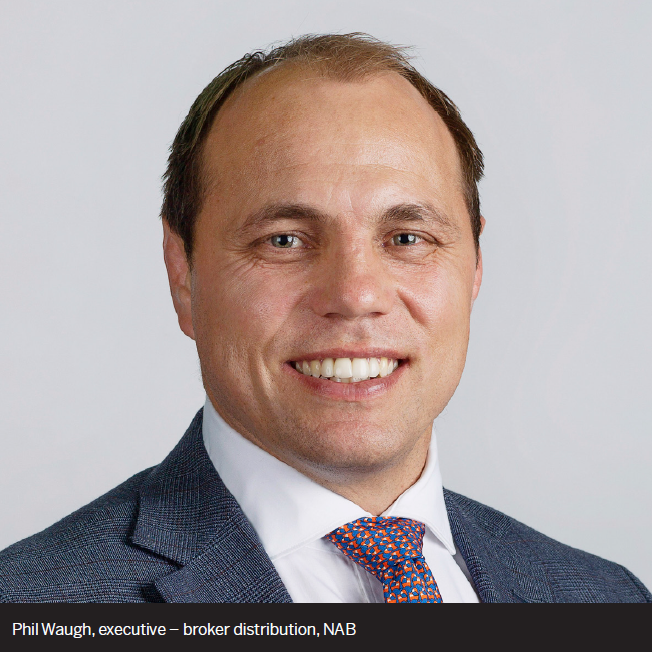 Property market, loan demand
Property market, loan demand NAB executive – broker distribution Phil Waugh says the pandemic has fundamentally changed how Australians purchase a home.
The latest NAB research suggests that almost one in 10 Australians have moved either within their own or to another state or territory because of COVID and are not planning to return.
“We continue to see strong momentum across all segments of the property market. NAB is very much open for business with great SLAs, products backed by highly competitive pricing, and offers for every customer in the market,” Waugh says.
“According to CoreLogic, investors are the fastest-growing sector of the market, with plenty of upside still to go. NAB is well positioned to help investor clients grow.”
Waugh says NAB has seen great loan growth, with application volumes increasing significantly.
“We want to make the experience of buying a home simpler for all our customers and to support them with the confidence of an approval as quickly as possible, regardless of channel.”
Process changes are having a positive impact by ensuring that NAB’s service is stable and consistent.
“Some of these changes are part of an ongoing review of our entire end-to-end broker experience, which we are determined will make us the most reliable bank for all brokers and ensure consistent service across all channels,” says Waugh.
“Our latest broker NPS saw an increase to +10, which demonstrates that we are moving forward in the right direction.”
Mohnacheff says despite the challenges of a crowded property market, first home buyers have remained a key demographic, with savvy buyers taking advantage of the First Home Loan Deposit Scheme and the First Home Loan Super Saver Scheme.
Understanding the challenges first-time buyers face, Liberty works closely with its business partners to provide flexible solutions to help customers reach their goals faster.
“As well as low-deposit home loans, we accept gifted deposits, and we can also look at building LMI into the loan structure. These options can make a powerful impact on a first home buyer’s borrowing ability,” Mohnacheff says.
“With greater need for flexible lending options across the board, Liberty’s loan growth has continued on an upward trajectory, and we are well placed to help customers achieve their goals.”
To maintain the fast turnaround times and excellent service Liberty is known for, Mohnacheff says, internal processes have been refined to achieve maximum efficiency and avoid delays.
“We have also extended our Melbourne-based team to ensure that there is always someone available to help provide customers and business partners with fast answers to any questions that arise along the way,” he says.
 Barry Saoud, Pepper Money’s general manager mortgages and commercial lending, says, “We’ve witnessed record growth in the alternative and non-conforming space, and all signs point towards this remaining strong.
Barry Saoud, Pepper Money’s general manager mortgages and commercial lending, says, “We’ve witnessed record growth in the alternative and non-conforming space, and all signs point towards this remaining strong.
“Our originations hit a milestone by June; we’ve helped over 27,000 customers in the first-half period either purchase or refinance a home, or secure asset finance, a record in our 21 years of business. As we exit 2021, we continue to see application levels trekking well above pre-COVID, setting us up well for 2022.”
Mitchell says homebuyers were on an emotional rollercoaster in 2021 as they watched prices soar 20% across all capital cities.
“Brokers have had to really set the expectations around what exactly borrowers can afford and how much they’ll need for that all-important deposit,” she says.
The focus was again on refinancers who were keen to get a better deal or to take advantage of ultra-low interest rates. Mortgage Choice data shows that, in the 12 months to October 2021, about 39% of loans written were for refinances, followed by customers buying their next home (27%) and first home buyers (19%).
“Since April we’ve seen a slight uptick in investors re-entering the market. However, APRA’s increased interest rate buffer may slow this activity,” says Mitchell.
It’s been an incredible year for Mortgage Choice, she adds.
“We saw loan settlements grow 29% to almost $13bn in FY21, and we settled more than 37,000 home loans over that same time – an increase of 25% year-on-year.”
Lender turnaround times had improved but were still not where they needed to be, so in February Mortgage Choice launched its own white label product, Mortgage Choice Propel, delivering a verified home loan approval in rapid time.
Felton says the MFAA understands that loan volume can impact turnarounds. “But our data demonstrated some banks’ branches operating on two-to-five-day turnarounds, whilst brokers’ customers were forced to cope with turnarounds in some instances of up to 40 days and more.”
The MFAA played a crucial role in elevating dialogue and bringing greater attention to this differential that has made it harder for mortgage brokers to compete, says Felton.
“We told the story via select media, but also followed up with meetings with lenders, regulators and government, including ASIC, Treasury, the Treasurer’s office, the Chair of the Standing Committee on Economics, Assistant Treasurer and Minister for Housing, and finally – and importantly – with the ACCC.”
Felton says the improvement over the year has been pleasing, but work still needs to be done.
“Customers with similar complexity of circumstances should not receive different service levels based on the channel they choose to engage the lender with. We don’t ask for special treatment, just a level playing field for broker customers.”
Blethyn says NextGen.Net was able to support lenders and broker groups through its Industry Benchmark Reporting Service, providing trusted insights and analytics on key data points, including turnaround times.
“We also worked closely with our partners to maximise automation and digitisation to improve processing efficiencies and help deliver faster turnaround times.”
Arentz says growth in the value of the Australian residential property market over the past year surpassed expectations.
The pandemic has been notable for driving a strong shift in consumer sentiment towards lower-density living, and also for causing a flight from capital cities to regional areas.
“However, easing border restrictions and the eventual return of overseas students, immigrants and hospitality workers, as well as businesses and nightlife, are expected to reverse this trend and boost demand for city accommodation,” Arentz says.
“Australia’s residential property market is now settling into a period of somewhat slower growth in our mind. Nonetheless, it continues to provide compelling opportunities for experienced developers who know where to look and how to successfully deliver their projects.”
He says industrial property has been largely immune to the falling rents and vacancies affecting the commercial and office and retail sectors, with soaring demand for warehouse and logistics space driven by e-commerce growth and supply chain restructuring.
Arentz predicts the strength of demand and rapid increase in residential construction will eventually ease due to supply chain pressures, further labour cost escalation and rising land values.
At Rate Money, Gair says property market growth most certainly defied expectations.
“The demand that we saw at Rate Money was phenomenal.
In the last 18 to 24 months our average loan size has grown by over $150,000,” he says.
The company knew it had to grow with the market, Gair says.
“We are a big believer in reinvesting back into the business in order to better ourselves.”
Rate Money was heading into 2021 with 11 branches predominantly in NSW and 35 people across its network.
“Fast-forward 11 months and we have 21 branches, with another four ready to open in Q1 next year. On top of that, we now have over 100 people in the network, branches in three states, soon to be four, as well as settling $1.5bn for the calendar year.”
Rate Money and its funding partners have heavily invested in credit, credit staff and processes.
“We didn’t want our SLAs to blow out to 20, 30 or even 40 days as we’ve seen throughout the industry, and they haven’t.
We have remained in single figures for every single product we offer, and that’s something we’re extremely proud of.”
Saoud says technology is creating remarkable opportunities in alternative lending, and Pepper Money is reimagining how it delivers value to its customers and brokers.
“We are not interested in providing a generic digital offering. We want to give our customers and brokers a digital experience that complements and accelerates the strong service they expect,” he says.
Pepper Money is focused on process efficiencies and streamlining with increased automation, and on continuing to enhance its platforms and build better customer and broker experiences.
“Our multi-experience focus is all about bringing these things together so that our customers and brokers can get what they want, when and how they want it, no matter the channel.
“With record applications and originations this year, Pepper Money maintained our industry-leading turnaround time of one business day, illustrating how our unique platforms support scale to onboard a record number of customers with speed and efficiency.”
Saoud says there are plans to enhance the Pepper Product Selector (PPS) tool and cloud-based solution Pepper Resolve, targeting increased activation and usage among brokers to improve conversion and create new opportunities in new segments.
In 2021, the PPS provided a mortgage solution to over 13,000 customers, and 5,300 customers with Resolve.
“Sage is now processing over 20% of our mortgages volume, combining our cascading credit model with
a customer’s credit history and an automated property valuation to expedite approval. And Solana has increased our capacity to assess consumer loans by automating enquiry through to settlement with digital identity verification.
“Our broker network can expect us to continue supporting them to offer alternative lending options in the most consistent, transparent and innovative ways,” says Saoud.
Blethyn at NextGen.Net says the broker community is extremely open to new digital tools – anything that’s going to make their lives and their customers’ lives easier.
“The difficulty they’ve got is the variance between the lenders and what’s available to them, so it’s important for lenders to invest in as much automation and as many tools as possible for brokers to improve straight-through processing,” she says.
“When lenders utilise digital tools services such as ApplyOnline ‘eSign’ and the in-built Document Verification Service, the application process becomes much easier for the broker.”
Reily says many fintech lenders such as OnDeck have embraced the use of data in their lending decisions.
“By harnessing the power of data, OnDeck has not only been able to streamline loan applications; we have also been able to introduce Lightning Loans, which we can decision in as fast as 30 minutes,” he says. “We’re also one of the fastest in the country for unsecured loans up to $250,000.”
Reily says digitisation is being driven by its ability to lower unit costs; faster response times for brokers and customers; elimination of the ‘slow no’ that many small businesses experience; and the ability to gain a more holistic view of a business’s credit risk rather than a rear-vision approach.
At NAB, Waugh says more than 93% of its customer interactions now occur through digital channels, and the bank’s research shows that one in five Australians use a banking app every day. He says Australians are looking for ways to take greater control of their finances following the pandemic.
“Over the last 18 months, we have responded to changing customer behaviours to be more digital and to help customers to better manage and have control over their money every day.”
A review of the NAB customer’s home loan journey has focused on giving them greater flexibility and control by allowing more self-service options.
Waugh says recent updates to the NAB app now enable a home loan customer to immediately fix (or refix) their interest rate, amend a direct debit, vary key aspects of a loan, and work out how much equity they have in their property.
“No doubt the future may be digital, data and technology driven,” he adds, “but the essential role of brokers remains crucial.”
Felton says new technology will continue to play an important role as the industry finds ways to more efficiently attract and engage with customers in an increasingly digital world.
“With Consumer Data Right [open banking] rules being rewritten to allow consumers to share data with mortgage brokers as trusted advisers, it’s important that brokers and aggregators have appropriate capability, or third-party service providers, to allow them to leverage the opportunities open banking presents.”
Arentz says Trilogy Funds has a tailored portfolio forecasting platform designed to monitor individual loans and the loan book, with the ability to scenario-test a large number of possible outcomes.
“It is interactive, dynamic and multipurpose,” he says.
The platform is used for current and forecast loan assessments, loan progress, cost to complete and to monitor broader liquidity trends across the loan portfolio and fund.
“It enables us to provide quick turnarounds and agile responses to brokers, and to direct borrowers and loan updates in the current fast-paced property environment.”
Piening says the finance sector has embraced new methods, using tech tools such as video conferencing platforms to ensure consistent service, while some lenders have introduced DocuSign to their broker network to boost efficiencies.
“The majority of lenders and aggregators also shifted their focus to online education and digital PD days. These have drawn a large audience, and we expect the trend to continue.”
Digitisation can save time, reduce bureaucracy, and lead to far better outcomes for all parties, says Piening.
“COVID pushed brokers to accelerate digital strategies within their businesses, or in some cases to create them for the first time.”
Piening says commercial and asset finance lenders have typically been slow to adopt technology for identifying borrowers and signing paperwork, but “we are already seeing a move towards it”.
There have been plenty of mergers this year, including NAB’s 86 400 with UBank, REA Group with Mortgage Choice and Smartline, Lendi Group with Aussie Home Loans, and People’s Choice with Heritage Bank.
Mitchell, who now leads both the Mortgage Choice and Smartline broker groups under REA Group, says financial services businesses will always look for opportunities to scale up and set their future direction.
“At a time when there are plenty of disruptor businesses, those that are well established must be strategic to ensure their future place in the industry,” says Mitchell.
She says REA Group’s acquisition of Mortgage Choice is part of the group’s ambition to accelerate its financial services strategy and create Australia’s leading retail broking business.
“REA aims to deliver increased value for brokers, customers and business partners by leveraging the vast consumer audience on realestate.com.au, as well as its property market insights and data.”
Combining Mortgage Choice and Smartline to operate under one brand and platform was a carefully considered move.
“The great thing about bringing together these two businesses is how similar their foundations are. It’s these shared values that form the strong base for operating under the one brand,” says Mitchell.
Reily says mergers and acquisitions are to be expected as lenders look to achieve economies of scale, but bigger isn’t always better.
“Scale can also mean losing the human touch that is so important in the lending process. OnDeck’s research shows that 60% of small businesses say a key driver of trust in a lender is having people to speak to.”
Reily says this is why OnDeck takes a “high-tech, high-touch” approach, with BDMs selected for their small business lending experience and brokers encouraged to reach out if they have queries.
Piening says mergers have been driven by technology, competition and the need for scale. New, nimble, tech-driven entrants have challenged the major players by demonstrating a different and more cost-effective way to do business.
“M&A is also likely at a broker firm level. We have already seen activity in this space. This is likely to continue with brokers either looking to grow via acquiring competitors that service the same markets as them, or by acquiring broking businesses that service different market segments as they seek to diversify,” says Piening.
“Businesses looking to diversify will need to ensure they understand the markets they are moving into, and that is where education and mentoring will become increasingly important. CAFBA’s Education Council has been established to ensure these needs are met. Education and mentorship are vital to ensure customers continue to receive the right outcome.”
The biggest regulatory change in 2021 was the introduction of the best interests duty.
“Whilst the best interests duty is a significant change that was not easy to implement, it represents an unquestionable positive for every consumer who obtains credit assistance through a mortgage broker,” Felton says. “In so doing, the duty differentiates the mortgage broking offering from the credit assistance provided through lenders’ proprietary channels.”
The MFAA also engaged with regulators on behalf of the industry regarding remuneration changes, reference checking, breach reporting, remediation, and design and distribution obligations.
Felton says the changes have ensured that the interests and expectations of brokers and consumers are aligned, conflicts have been mitigated and there is a greater focus on information sharing and reporting of misconduct.
“This leaves our industry well placed to proudly and confidently face the impending 2022 review by the ACCC and Council of Financial Regulators.”
Bannister says the impact of BID has been neutral because most brokers were already operating to a standard that met BID requirements.
“We feel that BID will have certainly played a part in supporting growth as brokers can now say to their customers, ‘I must act in your best interests as I am obliged to by law’, and that is something the banks cannot say,” he says.
With credit growth running at about 7% and annual property market price growth of 20%, APRA’s tightening of loan serviceability buffers from 2.5% to 3% for APRA-regulated lenders was “probably right to take some steam out of the engine”, says Bannister.
“It might reduce borrowing limits by around 5%. We think it’s more designed to be a ‘shot over the bow’ to signal to the market that things probably need to cool a little … if not the regulator has foreshadowed additional levers are available.”
While some banks want to extend the serviceability limits to non-ADIs, Bannister says the non-bank sector’s market share of 5% is not enough to cause systemic risk, and it’s unlikely the regulator will act.
“This ensures borrowers that are creditworthy are not marginalised or turned into ‘mortgage prisoners’, as non-banks can appropriately provide credit at this time.”
Vala says brokers will need to consider ADIs’ tightening policies, and APRA’s move to lift serviceability rates, which is likely to result in reduced borrowing capacity of about 5%.
“Debt-to-income limits could be implemented in the near future. It’s important brokers work with lenders who are constructively aware of these issues and their ramifications.”
Waugh says NAB welcomed APRA’s move to increase the minimum interest rate buffer, and the bank has now begun to implement the changes.
“We see this as a sensible change of policy considering the broader environment for house prices,” he says.
Mitchell believes APRA’s tightening of interest rate buffers is likely to have a modest impact.
“Brokers are likely to see the most impact occur for customers that are on the fringes of being approved for home loans.”
Piening says BID does not apply to commercial and asset finance lending. The industry is self-regulated, which has delivered great customer outcomes. CAFBA successfully campaigned years ago to ensure responsible lending (RL) did not apply to business lending, but Piening says over time elements of RL have crept into commercial finance, reducing accessibility to finance for SMEs.
“We support the proposed changes in RL and are campaigning for the Senate to accept them.”
Commercial and asset finance brokers are self-regulated, Piening says, and this has delivered great customer outcomes. CAFBA is currently reviewing the self-regulation model as it seeks to bring in a recognised professional qualification for commercial and asset finance brokers, similar to a CPA or a CA.
“This is an exciting opportunity for the industry, with a working group looking at the opportunities available to us. Recommendations will be provided to the board over the next few months,” says Piening.
The introduction of open banking in Australia last year, starting with the big four banks, is a game changer for the financial services industry.
“Open banking offers an opportunity to streamline the lending process by addressing major pain points for lenders, brokers and customers,” says Blethyn.
NextGen.Net research reveals that brokers are most excited about the data they can access, enabling them to engage with their clients earlier, to better tailor solutions, and to deliver ongoing services beyond home loan applications.
“With mortgage brokers now included as trusted advisers under the CDR, it’s amazing recognition of the value they deliver and will also give open banking the best chance of delivering better outcomes for consumers.”
NextGen.Net is excited to be delivering open banking solutions through ApplyOnline to its customers and users, Blethyn says; this will help the broker see a more meaningful and accurate financial picture of their client.
Mitchell believes open banking will allow the broking industry toadvance towards completely digital brokers and brokerages.
Felton says it’s really important that brokers were included in open banking to avoid a competitive disadvantage going forward. It was pleasing that earlier in the year, following three years of advocacy by the MFAA, Treasury acknowledged the importance of including mortgage brokers, followed by alterations to the open banking rules, which were originally too onerous for brokers to meet.
The MFAA will continue to work with the Treasury to make sure the rules are fit for purpose.
While open banking has limited impact on commercial brokers, Piening says overall the benefits will include differential pricing and new products.
“Customers with a good credit history will be able to leverage their standing to a greater degree than in the past,” he says.
While small businesses have struggled this year, as pandemic restrictions ease and the economy rebounds, SMEs are looking to access finance, which is good news for brokers.
“There’s so much business and growth potential among the new and upcoming generation of underserved borrowers, the rebounding small business sector, and the growing self-employed market that are looking for products and options that are built to accommodate their real-life circumstances,” says Saoud.
As more consumers with diverse financial backgrounds seek someone who understands them and is willing to look at their unique situation, he says brokers will become more vital.
“Our broker network can expect us to continue supporting them to offer alternative lending options in the most consistent, transparent and innovative ways to meet their customers’ evolving needs.”
Waugh says the opportunity to diversify into commercial lending is real, with strong momentum in the regional and agricultural sectors and increased capital city demand for equipment finance solutions to support advanced manufacturing.
“Assets such as industrial land and warehousing are also in high demand. This increased demand provides brokers with an opportunity to approach the needs of their customers holistically, using multifaceted funding solutions,” he says. “Fast and easy access to funds is critical for small businesses as they bounce back.”
As the nation’s largest business bank, NAB has hired an extra 134 SME bankers across 60 locations this year and introduced its Secure Lend product, which allows small businesses to borrow up to $2m.
Felton says commercial lending remains a significant opportunity for many mortgage brokers who are looking to diversify income streams and protect themselves against possible future property downturns.
“Whilst MFAA data shows that more than 4,700 mortgage brokers are now writing commercial loans, this means there are in excess of 12,500 for whom this remains an untapped diversification opportunity.”
The MFAA offers its members the most comprehensive support provided by any association, Felton says.
This year the MFAA ran its commercial education program virtually, covering all business and commercial lending. The program and webinars will continue in 2022.
“We’ve also produced two essential e-books for brokers new to commercial lending, and delivered several webinars,” Felton says.
Bannister says SMEs are the engine room of the economy, accounting for about 35% of Australia’s GDP and employing 44% of the workforce.
Given that the events of the last 18 months meant an uncertain and complex path to finance, La Trobe Financial believes brokers are best placed to help small businesses navigate that path.
Bannister says brokers will have opportunities to help thriving SMEs build their businesses and to assist those needing to restructure to get through a challenging period.
“Customers long remember who helped them in their time of need.”
With La Trobe Financial offering a product suite covering residential, commercial, SMSF, development, rural, aged care and non-resident; removing barriers to entry for many specialised products; and providing customised training and education, Bannister says the company is well placed to help brokers diversify.
The lender anticipates a surge of demand for commercial finance, especially light industrial properties.
“We experienced a steady demand for commercial SMSF loans secured against commercial property, typically from SMEs looking to purchase the premises they operate their business from,” says Bannister.
Piening says brokers are diversifying their businesses, and with some being exposed to the risks of a limited number of income sources, “it made to sense to create others”.
“CAFBA welcomes this diversification but cautions against doing it haphazardly as it can lead to poor customer outcomes.”
Piening says the CAFBA Education Council can assist broker businesses that are looking to diversify into a different market.
CAFBA has observed specialist lenders emerging over the last two years, targeting niche sectors, and providing asset and commercial finance brokers with many additional options for their clients.
“Awareness of these new providers in the general business market is limited, however, so brokers have a key role to play in educating clients to consider options beyond traditional channels,” says Piening.
“Small businesses are going to require finance to rebuild their businesses, employ staff and take advantage of opportunities as they arise.”
Arentz says non-bank lenders such as Trilogy Funds work in an agile way with brokers and developers, and focus on a developer’s relevant experience, reputation, business quality and marketing plans.
“We see great opportunity in further diversifying our loan book and helping more brokers and developers with niche projects such as service stations, medical centres and disability accommodation.”
Arentz says Trilogy Funds is well versed in both urban and regional areas across Queensland, New South Wales and Victoria, with flexible funding solutions for developers needing fast finance.
Thinktank is known as a commercial property lender, but Vala says it has expanded its product offering to include residential and SMSF loans for PAYG, self-employed and SME borrowers.
One of the emerging trends is the demand from SMEs and the self-employed for residential lending products, he says.
“Although commercial did slow marginally during 2021, it still remained relatively solid, and we expect this to strengthen with border and social restrictions easing further in 2022 … brokers who are able to provide lending options across commercial and residential will be well positioned for growth.”
Vala adds that growth in commercial property funding through SMSFs will continue in 2022, providing brokers with a significant opportunity to diversify.
“In line with Liberty’s ethos, we continue to listen to feedback from our community, and we’re committed to exploring new ways to help more people get financial,” Mohnacheff says. “And with some exciting new projects and increased capabilities in the pipeline, we look forward to getting digital with you in the new year.”
Saoud says as Pepper Money heads into its 22nd year of business in 2022, the company has an exciting opportunity to leverage its core competencies through data insights and in-house technology.
“We have significant headroom to extend, connect and grow our real-life loan options for even more Australians,” he says.
“Fast turnarounds alone aren’t enough; we are relentlessly focused on delivering fast turnarounds with consistency and transparency in our credit decisioning.
“We know how critical real-time approval confidence and credit decisioning is to brokers, and we have recently launched with a major aggregator – with our goal to continue rolling this out across the aggregator industry.
“By leveraging existing and future technology, streamlining processes, product innovation, and strengthening our distribution footprint over the next year, we’ll be providing scalable and accelerated growth for brokers’ businesses.”
Blethyn says she’s excited to see brokers in the driver’s seat as they continue to be consumers’ number one choice and optimise new technology to deliver a better service to their clients.
“The technology available for brokers was so accelerated by COVID-19, which has meant the broker proposition far exceeds anything that they could have possibly imagined three years ago.”
She says one of the most exciting things to look out for is NextGen.Net’s ApplyOnline Financial Passport, which includes ‘NextGenID’ and ‘Access Seeker’ – two new tools that will offer some great new efficiencies for brokers.
NextGenID, a digital VOI service, will eliminate face-to-face onboarding and enable brokers to capture and verify ID requirements digitally at point of sale. Access Seeker will give brokers upfront access to consumer credit information held by credit bureaus within the ApplyOnline application and allow a broker to update and refresh the information in real time.
Bannister says the broker industry will receive a major boost on the back of COVID in 2022 and beyond.
“We expect to see broker share continuing to grow, targeting the 70% milestone, and we hope to see NBFI market share heading back to 10% and beyond.”
Bannister says La Trobe Financial is looking forward to helping Australians achieve their dreams of homeownership and financial independence.
NAB’s commitment is to deliver a simple and digital home lending experience for both brokers and customers, says Waugh.
“We’re on track to make unconditional approvals in less than an hour the norm with our new loan origination platform kicking off in early 2022,” he says. “The process will enable greater use of technology, minimising potential for errors and rework, and provide faster processing times, which is great news for brokers and customers.
“NAB will continue to be the bank behind the broker.”
Vala says the Thinktank team are optimistic about what 2022 holds for the industry and are looking forward to working alongside brokers in opening up new opportunities for growth and helping their clients strengthen and prosper.
“Whether it’s about diversifying into commercial lending or seeking SMSF accreditation, we encourage brokers to contact us via their aggregator or one of our relationship managers to start a conversation about how we can assist,” says Vala.
Felton says the MFAA is approaching 2022 with confidence and pride in the industry.
“As we prepare for 2022 and an impending regulatory review of broker remuneration, I believe the industry is in the strongest possible position to confidently face this scrutiny.
“We have incredibly strong industry data on our side – data that demonstrates mortgage brokers continue to support competition and produce positive consumer outcomes. It’s our firm belief there will be no case for change to remuneration in the upcoming 2022 review.”
Felton says the MFAA will also be backed by the powerful combination of the self-regulatory and legislative reforms implemented over recent years, ensuring a strong position ahead of the review.
“We will continue our advocacy on behalf of the entire industry to ensure we have a level playing field.”
Arentz says Trilogy Funds’ lending team is excited to continue to diversify its loan book with a wide variety of property projects across residential, commercial, industrial and retail sectors, and expand its geographic reach.
“Not all lenders are the same. In addition to a competitive rate, I would also suggest working with a lender who has deep experience in the industry, funds available when you need them, personal service and the ability to tailor the loan to your project.
“We are confident in our loan product offering and look forward to continuing to fill those gaps in the construction lending space as accessible, reliable and experienced construction funding specialists.”
Mitchell says as property supply increases and demand slows, she expects price growth to slow again in the first few months of 2022 and overall prices to rise by 5% to 10% over the year.
As the Smartline and Mortgage Choice businesses integrate over the next 12 months, she says there will be significant milestones to achieve.
“Change is difficult for people and businesses at the best of times, and whilst there are similarities, there are differences too. It’s about us taking the time to understand what those differences are and then working with the networks to identify how we bridge the gaps and move forward as one.”
Reilly says the OnDeck team, like all Australians, are looking forward to life getting back to normal.
“High vaccination rates should make lockdowns less of a possibility in the future, and that’s good for brokers, small businesses and the broader lending community,” he says. “We are also excited by the opportunity to partner with more brokers to fund more small businesses faster and more efficiently than ever before.”
Piening says CAFBA faces a number of challenges, including ensuring ready access to finance to assist businesses and individuals to recover from the pandemic. CAFBA also wants to keep professionalising the industry through self-regulation.
“Education’s role cannot be overstated. CAFBA welcomes new entrants to the market and will help them satisfy their clients’ expectations. We must continue to guarantee our sector can assist borrowers.
“I’m looking forward to a year without lockdowns and working closely with my clients to help them bounce back from COVID-19. It promises to be an exciting and very rewarding 2022!”
Gair believes the industry will continue to see the strong resolve of the Australian people.
“Due to the complexity of small businesses’ financial situations throughout the past two years,
I expect to see the demand for non-bank lending continue to increase as it has done over the past 24 months,” he says.
“I’m interested to see how the use of technology continues to change the landscape of lending. What I’m most excited to see is the hard-working self-employed people of Australia begin to prosper again after what has most definitely been a challenging 24 months.”
